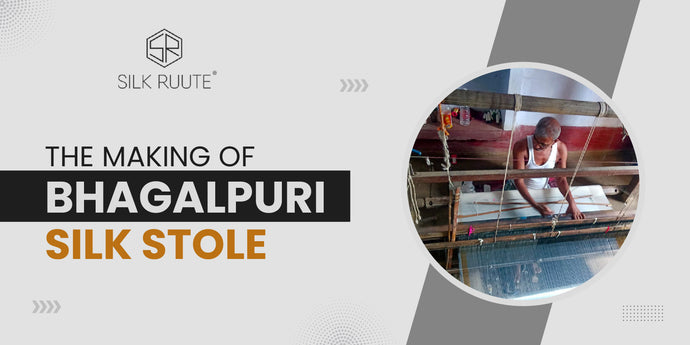
The Making of Bhagalpuri Silk Stole
You must have heard countless times that silk is a fabric of the royals or that it has been, for a long time, referred to as the queen of fabrics. The perfection of the golden-hued fabric or the beautiful details of this timeless classic has not been hidden from anyone. It is because of these reasons that silk is adored by people from around the globe.
Do you know which is the most refined form of silk fabric? Bhagalpuri silk! You may never have heard about it, but it’s true. The rich and delicate feel of this fabric doesn’t develop overnight but has tiresome hard work and splendid craftsmanship behind it. Bhagalpur has an incredible history of silk crafts, the traditions of which have been passed over centuries and generations.
However, this blog is not about the beauty of this traditional heritage of this fabric. In this blog, we will learn about how Bhagalpuri silk is weaved and turned into beautiful accessories such as stoles, scarves, shawls and sarees. You might be enticed to buy silk scarf online, but do you know the journey of a silk scarf before it adorns your outfits?
A Journey from Fibre to Fabric
If we are to talk about the journey of silk production, there are three major steps that are involved in it:
• Extracting fibres from the cocoon
• Dyeing of the yarn
• Weaving
Each step is exhaustive and includes a few steps so that a perfect silk accessory can be crafted out of a myriad of silk threads.
Step 1: Extraction
In the first process, i.e. extraction of fibres from the cocoon, the undamaged cocoons are boiled in water which softens them. In the boiling water, sericin gum is dissolved to facilitate the unwinding of the silk threads from the cocoon. After this, the process of reeling is initiated where threads are carefully reeled out from cocoons which is then wounded on bamboo spools.
Once this process is completed, these spools are transferred to skeins. After these are dried, a thicker, stronger and multi-threaded yarn is created.
Step 2: Dyeing
Now, we move towards dyeing the yarns that we have. Before the dyeing process, each yarn is bleached and dried. One must note that dyeing is done by using natural dyes. The yarn is then put in boiling water, and once the yarn is wet, dye is put to these wet skeins. To accelerate the dyeing process, these skeins are placed in a mordant solution.
Step 3: Weaving Process
During the weaving process, the warp beam and cloth roll are used. The warp yarns can be interlaced with the filling or weft yarns while being supported on the loom frame between the two cylinders to create the woven cloth.
After being removed from the loom, the fabric is washed with plain water and stretched out to dry. Once dried, water is again sprayed uniformly with a spray machine.
Every Bhagalpuri silk stole that you see is a result of arduous labour and fine workmanship of the silk weavers. An intricate and exhausting journey goes beyond the creation of your favourite silk garment. We hope the next time you purchase a bhagalpuri silk stole for women, you know the journey of fibre to fabric.
Similiar Blog: Cultivating the Queen of Fabrics – Silk: Sericulture & More!
Best Regards
For, Silk Ruute
Gaurav Sandilya
Proprietor
